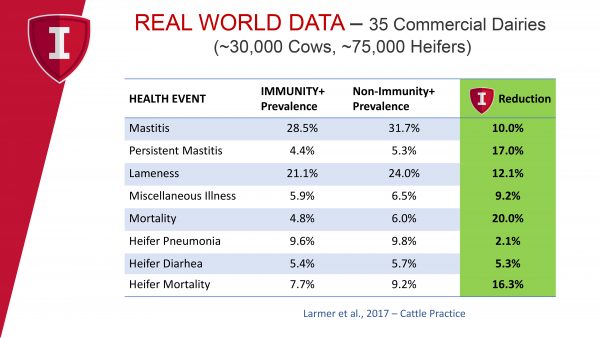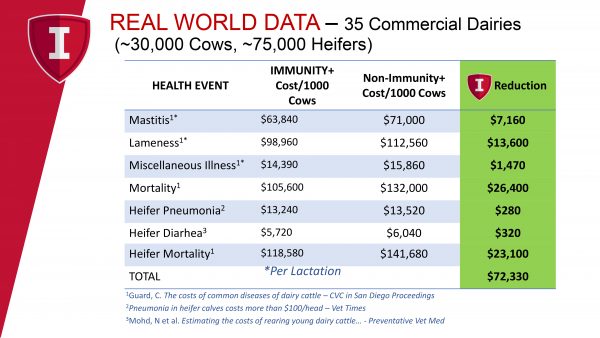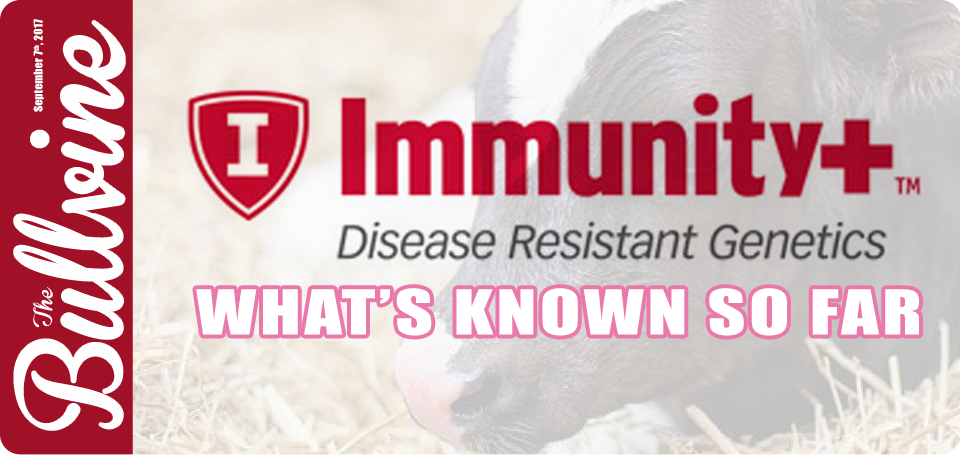There is no substitute for good animal health. Without it all other goals (production, genetics or showring) have only a limited chance of success. How so you say? Well, as I see it, the health of animals in herds in today’s world can have a significant bearing on the costs associated with medication, the labor and worry required to treat sick animals, the food safety of both milk and meat leaving the farm and very importantly the trust consumers can put in the dairy farm generated food they buy.
Immunity+™, a Semex exclusive program, was researched, designed and implemented to assist breeders with genetically improving the health of their animals.
Informing Breeders
With improving the genetic merit of the health of animals high on the want list of breeders, I was very interested when I became aware that Eastgen, one of the owning partners of Semex, was hosting an update day for Immunity+™. Eastgen did a first-class job of hosting the event at its Guelph Canada base, with speakers covering the technical, the results from field data and four breeder testimonials. Time for bull viewing, wholesome food and breeder-to-breeder chat time were added components to the event.
I must admit that going to the day I wondered what the field results for Immunity+™ would show.
The Technical Story – Immunity Can be Found in the Genes
Dr. Steven Larmer, from Semex, led the day off with a presentation that covered both the technical and an analysis of the field data collected to the present time.
- The Research on Immunity: Dr. Larmer covered the twenty-two years of research by Dr. Bonnie Mallard and her University of Guelph team on the genetic regulation of the immune system of livestock. Dr. Mallard’s program has produced almost 100 research papers from animals in both research and commercial herds. It was interesting to learn that Immunity+™ had recently had been awarded the very elite Canadian Governor General Innovation Award.
- Testing the Bulls: The proprietary University of Guelph testing service, that Immunity+™ is based on, challenges animals for both bacterial and viral infections and measures the animal’s ability to fight off the infections. It is an expensive hands-on test and only animals that are superior in their ability to fight off both types of infections are designated HH (High-High) for Immunity+™. About 10% of bulls tested receive the HH designation. Dr. Larmer also reported that the level required for an animal to be categorized as high resistance will be a sliding scale. Over time animals will be required to be more and more resistant to be classified high resistance.
- Type of Diseases Covered: There are two categories of classification for the infection associated with Immunity+™: 1) from organisms from outside the cell (bacterial); and 2) from organisms from inside the cell (viral or mycobacterial). Bacterial infections (predominately controlled by AMIR) include mastitis, listeriosis, brucellosis, E. coli, scours, bacterial pneumonia, metritis and digital dermatitis. Viral and mycobacterial infections (predominately controlled by CMIR) include viral pneumonia, BVD, IBR, leucosis, foot & mouth TB, retained placenta and Johne’s.
- Genetic Improvement Possible: The research has shown that there is a slightly negative correlation between the animal ratings for the two tests and thus the reason why Immunity+™ requires that bulls be high disease resisters for both bacterial and viral infections. The heritability has been found to be 30% which puts it in the same league as milk production and thus can be improved by a selection program that directly selects A.I. bulls rather than through indirect selection on the end result such as SCS, PL/HL, DCE/DCA and DPR/DF of a bull’s daughters.
- The 4 Generation Effect: Dr. Larmer predicted that after four generation of using Immunity+™ sires the genetic ability for disease resistance of a herd could be improved from 5-10% in generation one to 20-40% in generation four.
Farm Study Results Show Improved Defense Against Diseases

A synopsis of the on-farm results provided, by Dr. Larmer, to breeder and industry attendees include:
- High Immune Cows Deliver Threefold: A study involving 64 North American herds has shown that high immune response cows: 1) have half the incidence of six named diseases as low immune response cows; 2) have higher quality colostrum with more antibodies as determined by the Brix Scale method; and 3) respond better to commercial vaccines. By the way, it was interesting to learn that, in general, 15%-30% of animals given a vaccine may not respond depending on the nature of the vaccine and thus will have no immunity.
- Immunity+™ Sired Daughters Deliver Health: A Semex study in 35 commercial dairies, containing 75,000 heifers and 30,000 cows, was reported by Dr. Larmer to show disease reduction rates of: 10% for mastitis; 17% for persistent mastitis; 12% for lameness; 9% for miscellaneous illness; 20% for mortality; 2% for heifer pneumonia; 5% for heifer diarrhea; and 16% for heifer mortality. There is more data for heifers than cows as the cows sired by Immunity+™ sires have only recently entered the milk production phase of their lives.
- Economic Return from Using Immunity+™ Sires: Economic analysis from the 35 herds shows total lifetime savings of $103 per Immunity+™ sired cows and that is without including the benefits of increased colostrum quality, stronger vaccine response, reduced vet costs, on-farm labor savings and any premiums possible from the sale of disease free milk or meat.
- Breeders Speak Highly of Immunity+™: The four breeder testimonials at the Eastgen hosted day all reported positive results from their Immunity+™ sired daughters. Most of their reports were for calves and heifers for the reason stated above that their first Immunity+™ sired females are just now in their first lactations.

The Story Continues
Other interesting facts and comments that breeders should be aware of include:
- Research is underway to find the genome association (genomics) relative to AMIR and CMIR.
- Brian O’Connor, Eastgen General Manager and MC for the event, reported that there is no extra cost, as Semex sires are not priced higher when designated Immunity+™.
- Currently almost 40% of the Semex dairy semen sales are from Immunity+™ sires.
- A study is not yet possible that compares the production performance in the milking herd of Immunity+™ and non-Immunity+™ sired cows. However, there are many high TPI/ LPI and NM$/Pro$ Semex sires that are Immunity+™ and therefore are available for breeders to use.
The Bullvine Bottom Line
The end to this update story has yet to be written. More data must be captured and analyzed, especially for milking females. However, if future field results hold up to what is currently known, sires that carry the Immunity+™ designation will be able to deliver high genetic resistance for a multitude of diseases.
Healthy animals, less drug use, lower vet costs, on-farm labor savings, safe food, satisfied consumers, prosperous industry, … dairy cattle breeders want and need them all. Understanding and using immunity genetic information can be a contributor to improved animal health and longevity.

Get original “Bullvine” content sent straight to your email inbox for free.














